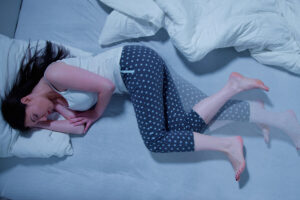Restless Leg Syndrome
Most people associate restless leg syndrome (RLS) with sleep, but it can also affect you while you’re awake. However, it most often occurs later in the day and toward nighttime.
Individuals with RLS often experience an uncomfortable sensation in their legs while sitting or lying down. Moving the legs can temporarily relieve this sensation, but it requires constant movement. This uncontrollable urge can interfere with relaxation and sleep if left untreated.
RLS can develop at any age, and unfortunately, it can worsen over time without treatment.

Common Signs and Symptoms of Restless Leg Syndrome
- Urge to Move the Legs:
- A strong, often irresistible urge to move the legs, typically accompanied by uncomfortable sensations.
- The urge to move often worsens when at rest, such as when sitting or lying down.
- Uncomfortable Sensations:
- Described as creeping, crawling, itching, tingling, or burning sensations in the legs.
- These sensations typically occur deep in the legs, between the knee and ankle. They can also affect other parts of the body, such as the arms.
- Symptoms Occur at Rest:
- Symptoms are usually triggered by inactivity, such as lying down or sitting for extended periods, such as in a car, airplane, or at a desk.
- Relief with Movement:
- Moving the legs or walking often provides temporary relief from the uncomfortable sensations.
- Stretching, jiggling the legs, or pacing can help alleviate symptoms temporarily.
- Worsening of Symptoms in the Evening or Night:
- Symptoms are typically more severe in the late afternoon and evening and may worsen at night, affecting sleep quality.
- Sleep Disruption:
- Difficulty falling or staying asleep due to leg discomfort.
- RLS can lead to insomnia and contribute to excessive daytime sleepiness.
- Periodic Limb Movement Disorder (PLMD):
- Many people with RLS also experience PLMD, which involves involuntary, repetitive limb movements during sleep.
Potential Triggers and Risk Factors
- Genetic Predisposition: RLS can run in families, especially if it starts before age 40.
- Iron Deficiency: Low iron levels or anemia can exacerbate RLS symptoms.
- Pregnancy: RLS is common during pregnancy, particularly in the last trimester, but often resolves after childbirth.
- Chronic Conditions: RLS is associated with certain chronic conditions, such as Parkinson’s disease, diabetes, and peripheral neuropathy.
- Medications: Some medications, including certain antihistamines, antidepressants, and antipsychotics, can trigger or worsen symptoms.
- Lifestyle Factors: Alcohol, caffeine, and nicotine consumption may aggravate RLS symptoms.
When to Seek Medical Advice
If you experience symptoms of RLS that affect your quality of life or interfere with sleep, it’s important to consult a healthcare professional. They can help diagnose the condition and recommend appropriate treatments, which may include lifestyle changes, iron supplements, medications, or other therapies to alleviate symptoms and improve sleep quality.
Although circadian rhythm disorders are not inherently dangerous, they can significantly impact your life. If left untreated, their effects can become serious. Fatigue can reduce performance and alertness at work or while driving. Poor sleep can affect your mood and even contribute to depression. Schedule a consultation today to regain control over your sleep.
Dr. Chernobilsky is an experienced sleep specialist who has helped many patients achieve a full night’s rest. With his expertise, he can help you get back on track and get the restful sleep you need and deserve. He will work with you every step of the way, tailoring your treatment to best fit your needs. Schedule your consultation to take the first step toward treating your restless leg syndrome.